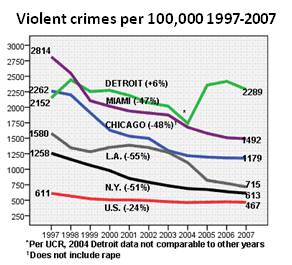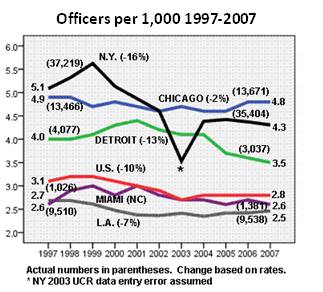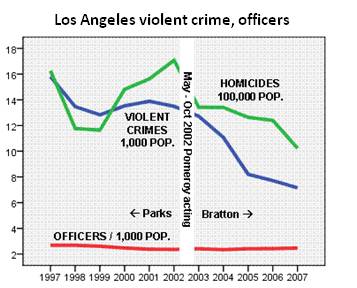|
Posted 3/22/09
A LARGER FORCE, BUT AT WHAT COST?
As crime falls, LAPD’s growth threatens other city services
For Police Issues by Julius (Jay) Wachtel. Even as he pushes a $74 million deficit into the next fiscal year, when the shortfall is predicted to rise to $433 million, recently-reelected Los Angeles mayor Antonio Villaraigosa is sticking to a long-standing campaign promise, made well before the financial meltdown, of adding 1,000 cops to the city’s payrolls. Other than for a few minor adjustments, public safety is off the table.
Yet what’s left over is pitifully small. Police and fire together consume seventy percent of revenues, so balancing the budget on the backs of other departments might call for as many as four-thousand layoffs, affecting key services including sanitation, public works, libraries and parks. It’s why City council members Greig Smith and (former police chief) Bernard Parks suggest putting the brakes on LAPD’s expansion until the economy improves.
Click here for the complete collection of resources, selection & training essays
But Hizzoner won’t hear of it. “Let me make something clear,” Villaraigosa said. “I am not talking about the slowing down of our police recruitment effort. These numbers are irrefutable; L.A. is safer than at any time since the 1950s.” Police Chief Bratton quickly chimed in, saying that throttling back on police hiring wouldn’t solve things, and that in any case the city council had already signed off.
Everyone knows that crime in the City of Angels has been dropping for years. Only question is, did the number of cops have anything to do with it? Poring through a decade’s worth of FBI crime statistics yielded some tantalizing clues.
Overall, violent crime fell twenty-four percent between 1997 and 2007. Many large cities experienced dramatic declines: forty-seven percent in Miami, forty-eight percent in Chicago, fifty-one percent in New York and a stunning fifty-five percent in Los Angeles. Murder (including non-negligent manslaughter) also fell, with Chicago and New York enjoying plunges of forty-three percent.
What accounts for the remarkable improvement? Most criminologists point to socioeconomic factors. Some also credit the incapacitative effect of so-called “three-strikes” laws, which imposed substantially longer prison terms on violent felons and recidivists. And yes, the police probably played a role. But it wasn’t because of numerical strength.
Indeed, police staffing has receded most everywhere. As NYPD lost sixteen percent of its cops (it’s down nearly 2,000 officers, and still shrinking) murder also declined, by a full forty-three percent. In sunny L.A., where the officer/population ratio fell by seven percent, murder tumbled an impressive thirty-seven percent.
If we believe City Hall and Parker Center, L.A.’s improvement is mostly due to Chief Bratton and his vaunted Compstat. But as the chart below demonstrates, violent crimes peaked in 2001, so the decline was already underway when Bratton took over in October 2002 (he replaced Acting Chief Martin Pomeroy, an LAPD retiree who stepped in after Parks left.) The homicide free-fall did start in 2003; however, its previous path was very unstable, so attributing the drop to a change in command -- it was Bratton’s first year -- is highly questionable.
While police around the U.S. are simply trying to keep the cops they’ve got -- NYPD recently reduced its force by 1,000 and canceled an academy class -- Mayor Villaraigosa seems determined to proceed. Already underway, the hike of 1,000 officers will increase coverage about eight percent, from 2.5 to 2.7 per thousand, a boost that in a city as as large and spread out as Los Angeles can’t yield a visibly increased police presence. As we mentioned in an earlier posting, LAPD’s relatively generous salary and benefits schedules make it impossible to reach the far higher levels of coverage that citizens in the eastern U.S. enjoy (depicted in the above chart, it’s nearly twice L.A.’s per capita.) Anyway, what would be the purpose? Their rates of violence are no better.
Be sure to check out our homepage and sign up for our newsletter
Short of tripling or quadrupling the number of officers, something that no one’s suggesting, adding cops will have little effect on crime. Sure there will be more arrests, but those that really count require solid evidence -- which in stranger violence often means catching someone at or near the scene -- and cooperating witnesses. How a marginally larger force will accomplish these ends no one’s said. What it will do is further erode other city services. Villaraigosa didn’t mention this tradeoff during his 2005 campaign, but things were different then. Now that we’re all a bit poorer surely he would be forgiven a midcourse correction. After all, a civil society requires more than police.
Did you enjoy this post? Be sure to explore the homepage and topical index!
Home Top Permalink Print/Save Feedback
RELATED POSTS
Why the Drop? Just How Thin is L.A.’s Thin Blue Line?
|